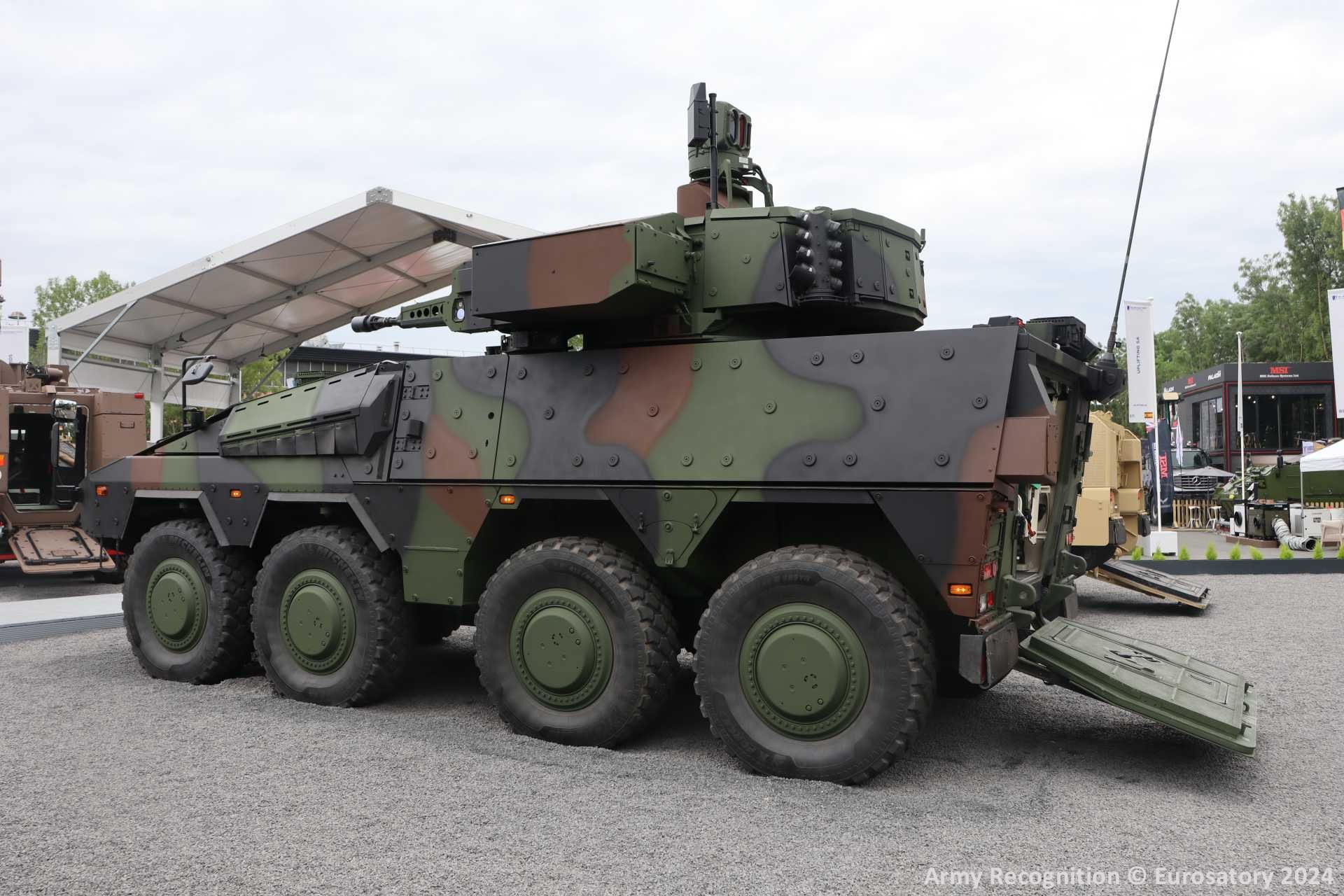Breaking News
Exclusive: Germany confirms delivery of nine Boxer RCT30 IFVs to defend Ukraine's artillery from Russian drones.
On January 14, 2025, Germany confirmed the delivery of nine Boxer RCT30 infantry fighting vehicles integrated with a mobile fire direction center to Ukraine. Designated AiTO30 FDC, these vehicles are equipped with systems specifically designed for counter-drone operations to protect artillery units from aerial threats. This delivery aligns with a prediction made by Army Recognition on May 29, 2024, which anticipated the transfer of a Boxer variant called "EITO" or "AITO," addressing both ground and aerial threats.
Follow Army Recognition on Google News at this link

The Boxer RCT30 is expected to operate alongside the RCH 155 Boxer-based self-propelled howitzer, delivering fire support, troop transport, and short-range air defense, as well as addressing drone threats. (Picture source: KNDS)
The Boxer RCT30 provides the Ukrainian military with the capability to engage both ground targets and drones. The vehicle is equipped with the stabilized MK30-2/ABM 30mm automatic cannon, capable of engaging targets from both stationary and mobile positions. Its modular design and advanced sensors improve situational awareness and allow adaptability to different combat scenarios. The RCT30 is expected to operate alongside the RCH 155 Boxer-based self-propelled howitzer, delivering fire support, troop transport, and short-range air defense, as well as addressing drone threats.
Russian drones, notably the ZALA Lancet loitering munitions, have been employed to target Ukrainian self-propelled howitzers. For instance, a video published on social networks on June 23, 2023, shows a Ukrainian CAESAR 155mm 6x6 self-propelled howitzer, donated by France, being destroyed by a Russian Lancet loitering munition in the Zaporizhzhia Oblast. Additionally, Russian forces have reported the destruction of Ukrainian AHS Krab howitzers in the Svatovo and Krasny Liman areas. In response, Ukrainian forces have implemented countermeasures, such as installing protective cages around their artillery pieces, to mitigate the impact of these loitering munitions.
Combining infantry support with air defense capabilities has historical precedents. During World War II, Germany used the Wirbelwind, a Panzer IV-based platform armed with a quadruple 20mm Flakvierling cannon for anti-aircraft and infantry support. In the Cold War period, the Soviet BMP-2 featured autocannons, while the American M6 Linebacker, a variant of the M2 Bradley, integrated air defense missile systems with infantry support functions. Modern vehicles like the Swedish CV90 series include variants designed for similar dual roles. The RCT30-equipped Boxer reflects these trends with updated technologies and modular configurations.
The RCT30 turret is equipped with the MK30-2/ABM automatic cannon, which has an effective range of 3,000 meters and a firing rate of 200 rounds per minute. A dual-feed system enables the use of two types of ammunition. The turret offers a 360-degree azimuthal rotation and an elevation range from -10° to +45°. It also features a coaxial machine gun and the SPIKE LR guided missile system, enhancing its capacity to engage ground and aerial targets. Additional features include programmable airburst ammunition, laser warning systems, and counter-drone capabilities. The unmanned turret design improves crew safety and integrates with command and control systems for networked operations.

The Boxer RCT30, referred to as "PuBo" due to its use of the Puma IFV turret, is armed with the MK30-2/ABM automatic cannon, which has an effective range of 3,000 meters and a firing rate of 200 rounds per minute. (Picture source: KNDS)
The Boxer RCT30, referred to as "PuBo" due to its use of the Puma IFV turret, was developed by ARTEC, a joint venture of Rheinmetall and KNDS Germany. It is powered by an MTU 8V199 TE21 engine generating 815 horsepower, allowing speeds over 100 km/h and a range exceeding 700 km. The vehicle has a combat weight of 38.5 tons and an internal volume of 14 cubic meters, supporting a crew of three and providing seating for six infantry soldiers. The vehicle's modular armor and C4I system allow it to integrate into tactical networks, enabling real-time navigation and command updates. Its roles include infantry transport, command escort, and drone defense.
Germany’s delivery of these vehicles is part of a broader military assistance program to Ukraine, supported through security capacity-building initiatives. The program includes production, upgrades, and training for Ukrainian operators. According to Ukrainian Ambassador to Germany Oleksii Makeiev, these vehicles, alongside Boxer-based RCH 155 howitzers, are intended to strengthen Ukraine’s military capabilities. The RCH 155 was the first Boxer combat vehicle delivered to Ukraine.
The Boxer platform has been adopted internationally since production began in 2008. Germany plans to procure 150 Boxer RCT30 units by 2029 to modernize its Medium Forces grenadier units, as well as 123 Boxer sWaTrgInf Heavy Weapons Carriers. The Netherlands has ordered 72 units for its 13th Light Brigade, and Lithuania completed the procurement of 91 Boxers across five configurations by early 2024. Australia operates Boxer Combat Reconnaissance Vehicles in five variants. The United Kingdom rejoined the program in 2018, initially ordering 523 units in four configurations for eleven roles, later increasing the total to 623 units.

The Boxer RCT30 infantry fighting vehicle has a combat weight of 38.5 tons and an internal volume of 14 cubic meters, supporting a crew of three and providing seating for six infantry soldiers. (Picture source: Army Recognition)


























